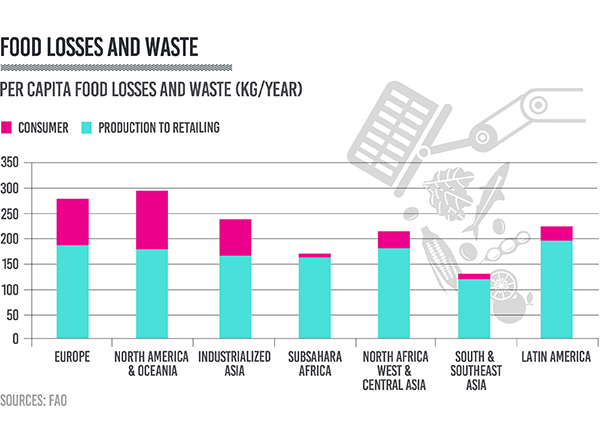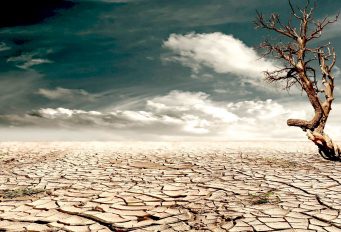![]() 5 minute read
5 minute read
Across the globe, nearly 30% of food goes to waste throughout the agrifood supply chain. According to the latest data, 70% of the EU food waste arises in household, food service and retail sectors. As the awareness of the problem grows, more solutions have to take place. This article investigates the need for consumer behavior change, a global monitoring system, and innovation to prevent food aging.
Food appearance
discrimination
Inefficient global agriculture supply chain results in nearly 30% of food waste. In EU, out of a total of 88 million tonnes of food waste, 47 million is produced by households. The overall financial loss is €143 billion in the European countries. The desire of food aesthetics, or beauty discrimination, cause retail to dispose of “ugly food”. Consumer behavioral need to change to accept fruits and vegetables that are blemished and not perfectly shaped while tasty and nutritious. And here is when marketing and behavioral economics come to help. Professor Lauren Grewal at Dartmouth’s Tuck School of Business published a study evaluating human habits in grocery retail. The 50-pages report evaluated different strategies of increasing “ugly food” sales.
Researchers found that positive framing of the products was less efficient than boosting shoppers self-esteem. “We found that the only thing that explained consumers’ devaluation of unattractive produce was their momentary self-perceptions,” Grewal says. Specifically, “when consumers imagine consuming unattractive produce, it generates self-signaling effects, prompting them to perceive themselves more negatively and, consequently, reducing their purchase of, choice of, and willingness to pay for unattractive produce. In that moment, a consumer’s self-perceptions are immediately lower than they would be if they were imagining themselves eating that perfect strawberry.” As a result, self-esteem boosting signs like “You are Fantastic! Pick Ugly Produce!” could increase revenue in the category by 12.6%.
Poor policy
and a good roadmap
The trend shows that in medium- and high-income stages food is disposed or not well handles at later stages in the supply chain. At the same time, low-income countries lose 40% of food during post-harvest and processing stages. The reason is poor infrastructure and lack of technological advances. Thus, there is a need for solutions to handle harvest better for its longer storage time. In the US, 1.3% of GDP, or $218 billion spent on waste food management. Hotel, restraint, cafe, and grocery retail business disposed the food instead of donating it due to available laws. Due to liability, it is less risky to throw away the extra food. Jacob Gersen, Harvard Law School professor and director of the Food Law Lab, says that “often it is easier to do the wrong thing; or rather, the law has made wasting food the only thing for many restaurants.”

Ninety organizations in Britain signed the Food Waste Reduction Roadmap to halve the food waste by 2030. UK’s largest retailers, food producers, and manufacturers commit to reducing the food loss of over £20 billion a year from farm to fork. To begin with, food waste to sewer, composting, landfill and other disposals will be robustly and routinely quantifies. Large companies will report their operations creating new ways to reduce food waste and exchange case studies. Along with these measures, food redistribution to people, animal feed and biobased materials are separately quantified and their share is expected to grow over time. In practice, the reporting is performed using an online tool The Food Loss and Waste Atlas. Atlas will capture global food loss and waste data in one place.
Long live
the fruits
According to FAO, fruits and vegetables, plus roots and tubers have the highest wastage rates of any food. In the US, startups aiming to reduce the food waste raised $125 million in 2018. Californian Apeel Science has raised $70 million to continue developing innovative ways to delay the aging of fruit and vegetables by reinventing food waste and other plant material. Apeel creates a thin edible “peel” on the surface of the fruit or vegetable that naturally slows down its water loss and oxidation. In fact, the amphiphilic liquid coating increases the lifecycle of the product keeping its freshness longer. The company’s products battle the challenges of post-harvest food waste, over-packing, and costly controlled-atmosphere storage. The interest in innovation comes from both retailers and investors. For example, the Kroeger Co., America’s largest grocery retailer, signed a partnership agreement with Apeel to support their journey to zero waste.
If the food wastage was a country, it will close the top three polluters after China and the USA. Being around 4.4 GtCO2 eq per year, food wastage’s impact is bigger than India’s. The biggest contribution category is cereals, vegetables, and meats. Moreover, the further in the supply and consumption chain the food is lost the more carbon-intensive is the wastage. For instance, a vegetable spoiled in the field has lover footprint than the same vegetable wasted by the household.




